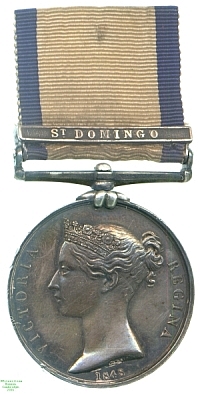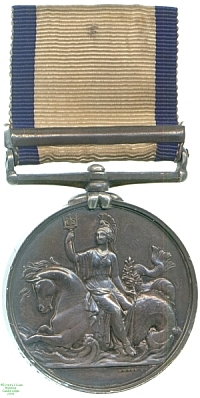
Obverse, a bust of Queen Victoria

Reverse, Britannia with a trident seated sideways on a seahorse

Obverse, a bust of Queen Victoria |

Reverse, Britannia with a trident seated sideways on a seahorse |
Just as in 1848 the extensive land campaigns of the Napoleonic Wars and the other conflicts of the pre-Victorian era were recognised by the issue of the Military General Service Medal, those serving in the Navy at the time were recognised with the Naval General Service Medal. As with the Army equivalent and the East India Company's related award, many of the battles for which the medal was awarded had been fought so long ago that few if any claimants survived.
In addition, bars were awarded for many actions whose significance and size were, despite the heroism displayed by those involved, relatively minor. The result was that many of the bars were issued in tiny numbers, with some combinations all but unique, and the medals command a very high price among collectors because of this rarity and individuality. This in turn, along with the manufacture in most cases of more bars than were eventually issued, has led to the `improvement' of many common awards where recipients' names are shared with those present at `rarer' battles. The medal also shares with the Military General Service and Army of India Medals the oddity that Queen Victoria, whose portrait they bear, was not the ruler under whom the battles for which it was awarded were fought.
Santo Domingo is a small island in the Caribbean which in 1806 was in French hands, and in use as a resupply base for French ships in the Atlantic because of the blockade of French ports that the Royal Navy was enforcing. On 6 February a squadron of five ships which had broken this blockade the year under Arrière-Admiral Leissegues before were in the process of resupplying when caught by a British force of seven ships of the line, 2 frigates and 2 lesser vessels, under Vice-Admiral John Duckworth. Surprised, heavily outnumbered and not in fighting condition, three of the French vessels were captured and two wrecked ashore; the three smallest vessels escaped. This was the Battle of San Domingo.
This medal was awarded to Able Bodied Seaman Simon Redgrave of the 24-gun frigate HMS Magicienne, which took no actual part in the battle. His service aboard her at this time has however been verified. Lester Watson purchased the medal at some point before 1928.